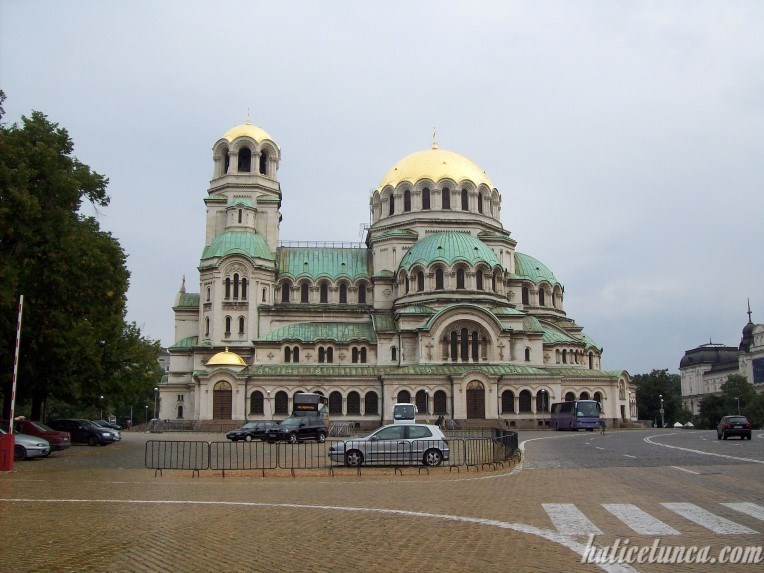The first station of our travel to Europe was Sofia, the capital of Bulgaria. Sofia means “Wisdom”. No time difference between Bulgaria and Turkey. We arrived at Sofia Central Bus Station after about 8 hour bus ride from Istanbul (Metro tourism-50TL). Currency is Bulgarian Lev (BGN). 1 Lev was equal to approximately 1 Turkish Lira. Turkish citizens who have regular passports need a visa to enter Bulgaria. We didn’t get Bulgarian visa, because we had Schengen visa and pass through Bulgaria to arrive Italy. At the border gate, we answered some questions like how long we will stay in Bulgaria, why do we transit, where are we going.. and, we crossed the border after showing our flight ticket to Treviso.
This was my first vacation. I have been abroad for the first time, I got on a plane for the first time, so it was an entertaining vacation for me.
Our Sofia route:
1. day – 04.09.2010
We were in the Sofia Central Bus Station early in the morning. We started to walk through Maria Luiza Boulevard after eating pastries and drinking daisy teas (I don’t like herbal teas, especially without sugar ![]() ) at the bus station.
) at the bus station.

We started our tour with Banya Bashi Mosque and Central Sofia Market Hall. Banya Bashi Mosque was built in 1566 by Architect Sinan and one of the oldest mosques in Europe. The mosque is located next to the Sofia Central Baths. So, it is named Banya Bashi. Also, it is named as Seyfullah Efendi Mosque because it has been founded by a philanthropist named Mullah Efendi Kadı Seyfullah. This mosque is the only mosque in Sofia which is open for worship.

The style of the Central Sofia Market Hall building is Neo-Renaissance, featuring also elements of Neo-Byzantine architecture and Neo-Baroque. It was opened in 1911 and today it is an important trade center in the city.

After then, we walked through Maria Luiza Boulevard and saw Nedelya Church.


Then, we went to the Church of St. George which is considered the oldest building in Sofia. It is built by the Romans in the 4th century and known about its frescoes. It is also called as Rotunda and it is transformed into a mosque in Ottoman period. It is restored in the 20th century and started to be used as a church again. It takes place in a garden behind of Presidency building.

After then, we arrived at Russian Church passing through Former Party House, Presidency, National Archaeological Museum and National Art Gallery in Tsar Osvoboditel Boulevard.



National Art Gallery has the largest art collection of the country.

Russian Church was very interesting with is golden colored domes.

And then, we went to Crystal Garden and had a rest. In this park, there was a monument of Stefan Stambolov who was the president of Bulgaria between 1887-1894 years.

And then, we went ahead the street and arrived at Statue of Tsar Alexander II. This statue located across the Parliament building and it is built in the name of Alexander II who known as one of the founders of Bulgaria after Bulgaria winning autonomy against the Ottoman Empire in 1877-1878 Ottoman-Russian War.

After then, we went to St. Alexander Nevsky Cathedral which considered as a symbol of Sofia. This is a Bulgarian Orthodox cathedral located in the center of Sofia, , built in memory of Russian soldiers who died in the 1877-1878 Ottoman-Russian War. The cathedral was built in the Neo-Byzantine style, which covers an area of 3170 square meters, with a capacity of 10,000 people and, it is the second largest cathedral in the Balkan peninsula after St. Sava Cathedral in Belgrade. The cathedral’s gold-plated dome is 45 meters high, the bell tower is 53 meters high. There were so many people in the gardens across the cathedral who were selling souvenirs. Not only souvenirs, but also different kinds of antiques are sold here.


Then, we took pictures of the Sofia University, the National Gallery for Foreign Art and Bulgarian Academy of Sciences.


Bulgarian Academy of Sciences founded in 1869 and it is the largest science foundation of the country.

After then, we saw the Holy Synod and the Hagia Sophia Basilica on the opposite of St. Alexander Nevsky Cathedral.

The Hagia Sophia Basilica is the second oldest church in Sofia, dating from 4.-6. century. Hagia Sophia means “Holy Wisdom” and gave its name to the city in 14. century. Although this church is overshadowed by the St. Alexander Nevsky Cathedral, it is one of the places that should not be missed.

After then, we went ahead Tsar Osvoboditel Boulevard and saw the Soviet Army Monument in the Prince Garden.

And then, we saw Eagles Bridge (Orlov Most) in the opposite of the garden and, we had lunch in Mc Donald’s in subway underpass.

After lunch, we went back from back Tsar Osvoboditel Boulevard and arrived at Ivan Vazov National Theatre. After seeing this magnificent building, we went to Sofia Airport (SOF) by bus for our Treviso flight.

